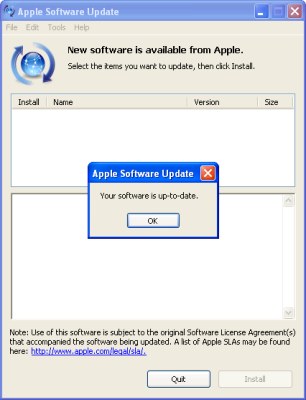- Installed IE8 RC1. Installer crashed, and I ended up with IE7…even though I’d been running the IE8 beta before.
- IE8 installer crashes system. New HW checks out. Bad RAM may have screwed something up before I replaced it. Time for System Restore. *grr*
- Wow, System Restore is taking a lot longer this time. Maybe it’s actually working? (Or maybe safe mode just makes it slower?)
- I can’t remember how many times I’ve rebooted this computer today. (And no, safe mode didn’t solve it)
- Finally got IE8 RC1 installed by telling it not to install updates immediately. The Malicious Software Scan was crashing the system. WTF?
- Now that I’ve FINALLY got IE8 RC1 running, a cursory check of websites I maintain shows no glaring problems. *whew!*
Tag: Windows
Alphabet Soup: XP SP and EV SSL XSS!
Sorry for the lack of updates this past week. I was just way too busy prepping for our move this weekend.
A couple of interesting news bits I noticed when I got into work this morning:
It looks like I’ve been lucky with installing Windows XP Service Pack 3. I’ve had no problems with the one machine I installed it on. According to Information Week, a lot of people are having serious problems with SP3, including BSOD on AMD-based systems.
Also, NetCraft has a screenshot of a PayPal page with both the green bar of an Extended Validation (EV) SSL certificate and a cross-site scripting (XSS) vulnerability. It’s a step or two beyond the standard lock icon, but there are still limits to what an EV cert can tell you. Unfortunately PayPal and others are really trying to drum “green bar = safe” into people’s heads.
Apple UI Nitpicking
I appreciate that Apple offers a single software updater for all its free Windows software. But one thing annoys me about it.
It opens a window, then opens a message box showing a progress meter as it checks for updates. Only one problem: It fills out the “New software is available” caption before it actually checks.

New software is available… oh, wait, no it isn’t.
This isn’t an issue on Mac OS X, because the progress meter is shown as a sheet, which drops down from the top of the main window and obscures the caption. But on Windows, that caption is visible from the moment the window appears, saying that you really do have something new available, raising your hopes that maybe, just maybe, Apple has finally gotten around to releasing that new version of Safari, or that security fix for the flaw you heard about a week ago, then dashing them to the ground.
Or, less dramatically, it’s jumping to conclusions, providing potentially false information.
And then, even if it turns out there isn’t anything new, the caption stays in place…leaving you with two contradictory statements as to whether any updates are really available.
WGA False Positive Experience
Back in July(?) 2006 when Microsoft issued an update to the Windows Genuine Advantage tool, I figured I may as well install it (I’d be forced to eventually) on my one Windows box. So I installed it, and rebooted, and the login screen proclaimed loudly that Windows was not genuine. (Well, not literally loudly, it didn’t shout over the speakers or anything — which would be an interesting deterrent, now that I think about it.)
This came as something of a surprise, given that:
- This was a Dell, not some no-name computer.
- It still had the original OS install, and no hardware had been changed.
- The previous version of WGA had reported no problems.
I logged in, did some searching on Microsoft’s knowledge base, and found a link that said something like “Validate here.” I clicked on it.
To my surprise, it told me my copy was perfectly valid.
I eventually concluded that Norton Internet Security had blocked the initial validation attempt. Because there was no desktop shell, there was no opportunity for it to pop up a notice and ask me if I wanted it to let the data through.
After that experience, I can’t say I’m surprised that Microsoft found many of their false positives to be the result of security software. Admittedly, they were looking at registry changes, crypto problems and McAfee, rather than a transient error with Norton.
(Reposted from this comment at Slashdot, mainly so I can find it again easily without searching.)
Safari on Windows
 Wow. I have to admit I was not expecting this at all, but Apple has just announced they’re releasing the Safari web browser for Windows.
Wow. I have to admit I was not expecting this at all, but Apple has just announced they’re releasing the Safari web browser for Windows.
Increased consumer choice, of course, is a good thing. The most immediate benefit, though, is that Windows-based web developers (the majority) who haven’t been willing to buy a Mac to test their sites in Safari will be able to do full testing on all four major rendering engines: Trident (IE), Gecko (Mozilla/Firefox/etc.), Webkit (Safari) and Presto (Opera).
Also, there’s some really cool stuff available in recent versions of WebKit that will be great to have available for a wider audience.
Interesting thought: this may be the first browser released since Opera expanded to Linux in ~2000 that is available in the same version on Windows and Mac, but not Linux. Even when Internet Explorer was available for the Mac, it used a different engine than the Windows version did.
I wonder what impact this will have on the development of Swift. Its main claim to fame was porting WebKit to Windows, and it’s been months since their last release.
I also wonder what the status is on re-merging the KHTML and WebKit forks. It’s gotten to the point that Konquerer is only an approximation of Safari, making testing on Linux a little harder than it used to be.
No doubt there’s a 500-comment Slashdot discussion already.
Update: Slashdot’s all over it, and Opera Watch has a thread going as well.
Update 2: I’ve posted my thoughts on the implications for Opera. There’s an update at CSS3.info, where they have previews of upcoming CSS features available in Safari 3.
Update 3: I’ve updated the Alternative Browser Alliance to reflect Safari’s new status. This also solves a nagging doubt I’ve had as to whether the default browser on Mac OS should really be considered “alternative.” On Windows, it definitely is.
Update 4: The Webkit team and Web Standards Project have weighed in. The Windows version of WebKit should be available later today, which will be nice for following progress on issues as it moves from beta toward final version. It turns out there’s a regression and at least the Windows version no longer renders the Acid2 test correctly.
Update 5: The author of Swift says that Swift isn’t going away [edit: the blog has since vanished], and points out that “Swift renders more like a Windows Application, both in the GUI and in WebKit. Safari, looks just like OS X, similar to iTunes 6 and below.” Ever since Apple started porting apps to Windows, I’ve found something odd: A common complaint about third-party Mac software is that it doesn’t look and feel native (one of the big reasons we have Camino as well as Firefox), yet when Apple ports their own apps to Windows, it makes them look exactly the same as they do on Mac OS instead of making them work like native apps. I mentioned this to Katie yesterday and she suggested it might be a case of turnabout being fair play.